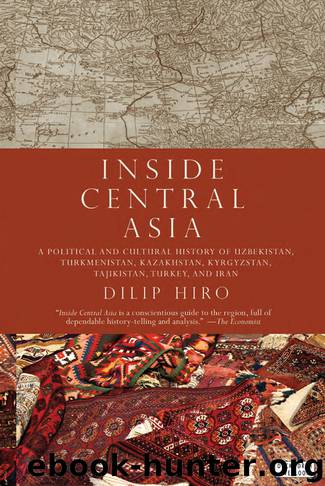Inside Central Asia by Dilip Hiro

Author:Dilip Hiro
Language: eng
Format: epub
Publisher: Gerald Duckworth & Co Ltd
BIRTH PANGS OF KAZAKH NATIONALISM
On that day, the state-run media announced that, following the resignation of Kunayev as the CPK’s first secretary due to “poor health and old age,” the CPK’s Central Committee had chosen Gennadi Kolbin, the then first secretary of the Communist Party of his birthplace, Ulyanovsk, 300 miles east of Moscow, to succeed him.
Kolbin’s sudden promotion to the highest party job in the Soviet Union’s second largest republic at a time when Kazakhs had reached demographic parity with Russians sent shock waves throughout the republic. The appointment of Zakash Kamalidenov, a Kazakh, as second secretary failed to pacify the popular anger. Kazakhs were unprepared to accept the reversal of primacy given to them for the past twenty-two years. Replacing Kunayev with Kolbin sharpened the contradiction that had existed between the center, Moscow, and the periphery, Almaty, strengthening Kazakh nationalism even within the Kazakh ranks of the CPK.
The next day there was a demonstration by about 10,000 people—mainly students, including ethnic Kazakh and Russian members of the CYL—in Almaty. Their placards read, “We are for Kazakhstan” and “Where is Kunayev?” Some of them shouted “Kazakhstan for Kazakhs!” When the armed guards ordered them to disperse, they refused. Communist Party leaders organized a counter-demonstration by workers, who came armed with metal bars and cables and attacked the student demonstrators. In the subsequent melee, which involved firing by the guards, between 2 and 20 people lost their lives, and between 763 and 1,137 were injured. More than 2,200 demonstrators were arrested.9
In twelve of the republic’s twenty regions, attempts were made to mount pro-Kunayev demonstrations, and thousands of protesting pamphlets were distributed. The Kremlin rushed a team of CPSU bureaucrats under M. S. Solomentsev to calm the situation. On arrival in Almaty, being patrolled by soldiers wearing bullet-proof vests, Solomentsev deplored the rising popularity of “extremism.” The authorities hinted that Kunayev had been behind the disturbances. Actually, Kunayev wanted to pacify the rioters, but Kolbin prevented him.10 It was not until mid-1988, when Kunayev had been out of the CPSU Politburo for a year, and when glasnost had advanced further in the Soviet Union, that the Izvestia (News) organ of the Soviet government conceded that Kunayev’s removal was seen “by certain young people” as “a blow against national esteem and pride, as the eclipse of their hopes.”11
The watershed event would later be portrayed, rightly, as the first spontaneous “democratic uprising” involving Kazakhs and Russians. Indeed, one of the three leaders—Andrei Statetin, M. Akuyev, and D. Kunayev— convicted for the rioting was a Russian. He received the harshest punishment, eight years’ hard labor for “stealing public property,” and expulsion from the party. Despite this, the episode came through as basically anti-Russian or at least as a rebellion by young Soviet-educated Kazakhs against the Russian “elder brother.” The presence of many people from the countryside led Yegor Beliayev, a Soviet expert on Islam and the Muslim world, to see the hand of Sufi brotherhoods.12
Kolbin reacted sharply, singling out the CYL for a severe
Download
This site does not store any files on its server. We only index and link to content provided by other sites. Please contact the content providers to delete copyright contents if any and email us, we'll remove relevant links or contents immediately.
| Anarchism | Communism & Socialism |
| Conservatism & Liberalism | Democracy |
| Fascism | Libertarianism |
| Nationalism | Radicalism |
| Utopian |
The Secret History by Donna Tartt(18743)
The Social Justice Warrior Handbook by Lisa De Pasquale(12080)
Thirteen Reasons Why by Jay Asher(8736)
This Is How You Lose Her by Junot Diaz(6701)
Weapons of Math Destruction by Cathy O'Neil(6084)
Zero to One by Peter Thiel(5637)
Beartown by Fredrik Backman(5545)
The Myth of the Strong Leader by Archie Brown(5374)
The Fire Next Time by James Baldwin(5199)
How Democracies Die by Steven Levitsky & Daniel Ziblatt(5096)
Promise Me, Dad by Joe Biden(5036)
Stone's Rules by Roger Stone(4989)
100 Deadly Skills by Clint Emerson(4798)
A Higher Loyalty: Truth, Lies, and Leadership by James Comey(4796)
Rise and Kill First by Ronen Bergman(4658)
Secrecy World by Jake Bernstein(4593)
The David Icke Guide to the Global Conspiracy (and how to end it) by David Icke(4557)
The Farm by Tom Rob Smith(4404)
The Doomsday Machine by Daniel Ellsberg(4375)
